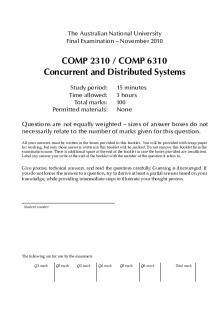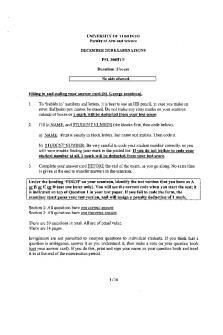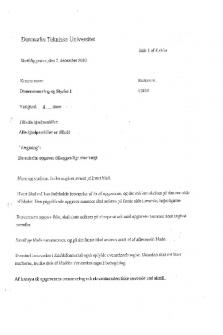Exam 2010, questions PDF

| Title | Exam 2010, questions |
|---|---|
| Course | Concurrent and Distributed Systems |
| Institution | Australian National University |
| Pages | 20 |
| File Size | 418.6 KB |
| File Type | |
| Total Downloads | 43 |
| Total Views | 135 |
Summary
Final Exam.2010.pdf...
Description
The Australian National University Final Examination – November 2010
COMP 2310 / COMP 6310 Concurrent and Distributed Systems Study period: Time allowed: Total marks: Permitted materials:
15 minutes 3 hours 100 None
Questions are not equally weighted – sizes of answer boxes do not necessarily relate to the number of marks given for this question. All your answers must be written in the boxes provided in this booklet. You will be provided with scrap paper for working, but only those answers written in this booklet will be marked. Do not remove this booklet from the examination room. There is additional space at the end of the booklet in case the boxes provided are insufficient. Label any answer you write at the end of the booklet with the number of the question it refers to.
Give precise, technical answers, and read the questions carefully. Guessing is discouraged. If you do not know the answer to a question, try to derive at least a partial answer based on your knowledge, while providing intermediate steps to illustrate your thought process.
Student number:
The following are for use by the examiners Q1 mark
Q2 mark
Q3 mark
Q4 mark
Q5 mark
Q6 mark
Total mark
Student number:............................................
1. [10 marks] Concurrency (a) [3 marks] Provide examples for events that can cause a process state to change • from ready to running. • from running to ready. • from running to blocked. • from blocked to ready.
COMP 2310 / 6310
Second Semester Exam 2010
Page 2 of 20
Student number:............................................ (b) [7 marks] You are asked to design a new programming language in which the compiler can automatically create concurrent code that can fully utilise multi-core CPUs, without the need for the programmer to explicitly define concurrency in the code. Which concepts / primitives / paradigms would you suggest to include in your new language? Name at least two, and give details why, how and under what circumstances they allow the compiler to create concurrent code.
COMP 2310 / 6310
Second Semester Exam 2010
Page 3 of 20
Student number:............................................
2. [14 marks] Synchronisation (a) [6 marks] In Ada protected objects, what is the difference between the requeue statement and a procedure call? Explain why the requeue statement is necessary, and provide a simple example.
COMP 2310 / 6310
Second Semester Exam 2010
Page 4 of 20
Student number:............................................ (b) Assume three tasks T1, T2 and T3 consisting of three distinct, sequential blocks of operations Ai → Si → Bi (each task first executes its Ai, then Si, then Bi ). Provide synchronisation code Si for each task so that no Bi starts execution before all Ai are complete. You may use pseudo-code, but be precise. Use the following primitives to implement synchronisation: (i) [4 marks] Asynchronous message passing: implement S1, S2 and S3 using procedure send(to_task, message) -- sends an asynchronous message to the specified task function receive() return message -- returns a received message, blocks if there is no message
COMP 2310 / 6310
Second Semester Exam 2010
Page 5 of 20
Student number:............................................ (ii) [4 marks] Synchronous message passing: implement S1, S2 and S3 using task entries as provided by Ada.
COMP 2310 / 6310
Second Semester Exam 2010
Page 6 of 20
Student number:............................................
3. Scheduling [8 marks] Task T1; Task body T1 is begin loop compute_for_2_time_units; T2.signal; end loop; end;
Task T2 is entry Signal; end; Task body T2 is begin loop compute_for_3_time_units; accept Signal; end loop; end;
(a) [4 marks] Schedule T1 and T2 using Round Robin. (Each time slice is one time unit long.) Task T1 starts 3 time units after Task T2. Show the first 10 time units.
[4 marks] Schedule T1 and T2 using First-Come-First-Serve. Task T1 starts 3 time units after Task T2. Show the first 10 time units.
COMP 2310 / 6310
Second Semester Exam 2010
Page 7 of 20
Student number:............................................
4. [12 marks] Nondeterminism Consider the following three versions of a task: task selector is entry E1; entry E2; end;
-- (identical)
-- (I) -task body Selector is begin for I in 1..2 loop select accept E1 do delay 1.0; Put (“1”); end; or accept E2; delay 1.0; Put (“2”); end select; Put(“3”); end loop; end;
-- (II) -task body Selector is begin for I in 1..2 loop select accept E1 do delay 1.0; Put (“1”); end; or delay 1.0; accept E2; Put (“2”); end select; Put(“3”); end loop; end;
-- (III) -task body Selector is begin for I in 1..2 loop select accept E1 do delay 1.0; Put (“1”); end; else accept E2; delay 1.0; Put (“2”); end select; Put(“3”); end loop; end;
-- main program begin delay 2.0; select Selector.E1; Put (“A”); else Put (“X”); end select; delay 1.0; Selector.E2; delay 0.5; Put(“B”); end;
COMP 2310 / 6310
Second Semester Exam 2010
Page 8 of 20
Student number:............................................ (a) [8 marks] Provide a time line of the program’s output for version (I), (II) and (III) of task body Selector. Indicate (in seconds) when certain outputs occur.
(b) [4 marks] Which version(s) of the program will not terminate, and why not?
COMP 2310 / 6310
Second Semester Exam 2010
Page 9 of 20
Student number:............................................
5. Safety and Liveness [34 marks]
(a) [4 marks] What are the necessary conditions for a deadlock?
(b) [6 marks] What is the difference between Deadlock Avoidance and Deadlock Prevention? Describe briefly how to prevent deadlocks.
COMP 2310 / 6310
Second Semester Exam 2010
Page 10 of 20
Student number:............................................ (c) The Banker’s algorithm can be used to detect deadlocks that are caused by multiple transactions holding locks on shared objects. (i) [4 marks] What information about current transactions needs to be available for the Banker’s algorithm to work?
COMP 2310 / 6310
Second Semester Exam 2010
Page 11 of 20
Student number:............................................ (ii) [10 marks] If the Banker’s algorithm declares the system as “safe” given the current state, and assuming that there will not be any new transactions, does this mean that there cannot be any deadlocks involving the currently active transactions? If the Banker’s algorithm declares that the system is not safe, does this mean that there will definitely be a deadlock? Justify your answers.
COMP 2310 / 6310
Second Semester Exam 2010
Page 12 of 20
Student number:............................................ (iii) [4 marks] Describe how the Banker’s algorithm can be used to avoid deadlocks.
(d) [6 marks] A customer wants you to design a “fail safe” control system for a pilotless robotic aircraft. What is a possible system behaviour that would need to be implemented to fulfil the customer’s request? What would you suggest if the customer asked you for an alternative approach?
COMP 2310 / 6310
Second Semester Exam 2010
Page 13 of 20
Student number:............................................
6. Distributed Systems [22 marks] (a) [2 marks] What are the necessary and sufficient conditions for two transactions to be serializable?
(b) [2 marks] What are the four “ACID” properties for transactions?
COMP 2310 / 6310
Second Semester Exam 2010
Page 14 of 20
Student number:............................................ (c) [6 marks] Two transactions T1 and T2 have conflicting pairs of operations on shared data objects A and B. Both transactions are executed concurrently on the shared objects, while making sure that serializability is maintained at all times. Transaction T1 encounters an error and aborts. How does this potentially affect T2? Give details on possible scenarios.
COMP 2310 / 6310
Second Semester Exam 2010
Page 15 of 20
Student number:............................................ [12 marks] The snapshot algorithm was introduced as a way to obtain a consistent snapshot of the system state in a distributed system. One problem for the process collecting the snapshot is how to decide when the snapshot is complete. Explain why this is a problem, and describe in detail how to decide when the snapshot is complete without making assumptions about message delays.
COMP 2310 / 6310
Second Semester Exam 2010
Page 16 of 20
Student number:............................................
continuation of answer to question
part
continuation of answer to question
part
COMP 2310
Second Semester Exam 2008
Page 17 of 20
Student number:............................................
continuation of answer to question
part
continuation of answer to question
part
COMP 2310
Second Semester Exam 2008
Page 18 of 20
Student number:............................................
continuation of answer to question
part
continuation of answer to question
part
COMP 2310
Second Semester Exam 2008
Page 19 of 20
Student number:............................................
continuation of answer to question
part
continuation of answer to question
part
COMP 2310
Second Semester Exam 2008
Page 20 of 20...
Similar Free PDFs

Exam 2010, questions
- 2 Pages

Exam 2010-2014, questions
- 6 Pages

Exam 2010, questions
- 20 Pages

Exam June 2010, questions
- 10 Pages

Exam 2010, questions
- 25 Pages

Exam June 2010, questions
- 10 Pages

Exam 2010, questions
- 2 Pages

Exam 2010, questions
- 3 Pages

Exam December 2010, questions
- 14 Pages

Exam 2010, questions
- 3 Pages

Exam 17 November 2010, questions
- 4 Pages

Exam 14 July 2010, questions
- 6 Pages

Exam 2010, questions and answers
- 5 Pages

Exam 2010, questions and answers
- 20 Pages

Exam 7 December 2010, questions
- 4 Pages
Popular Institutions
- Tinajero National High School - Annex
- Politeknik Caltex Riau
- Yokohama City University
- SGT University
- University of Al-Qadisiyah
- Divine Word College of Vigan
- Techniek College Rotterdam
- Universidade de Santiago
- Universiti Teknologi MARA Cawangan Johor Kampus Pasir Gudang
- Poltekkes Kemenkes Yogyakarta
- Baguio City National High School
- Colegio san marcos
- preparatoria uno
- Centro de Bachillerato Tecnológico Industrial y de Servicios No. 107
- Dalian Maritime University
- Quang Trung Secondary School
- Colegio Tecnológico en Informática
- Corporación Regional de Educación Superior
- Grupo CEDVA
- Dar Al Uloom University
- Centro de Estudios Preuniversitarios de la Universidad Nacional de Ingeniería
- 上智大学
- Aakash International School, Nuna Majara
- San Felipe Neri Catholic School
- Kang Chiao International School - New Taipei City
- Misamis Occidental National High School
- Institución Educativa Escuela Normal Juan Ladrilleros
- Kolehiyo ng Pantukan
- Batanes State College
- Instituto Continental
- Sekolah Menengah Kejuruan Kesehatan Kaltara (Tarakan)
- Colegio de La Inmaculada Concepcion - Cebu
